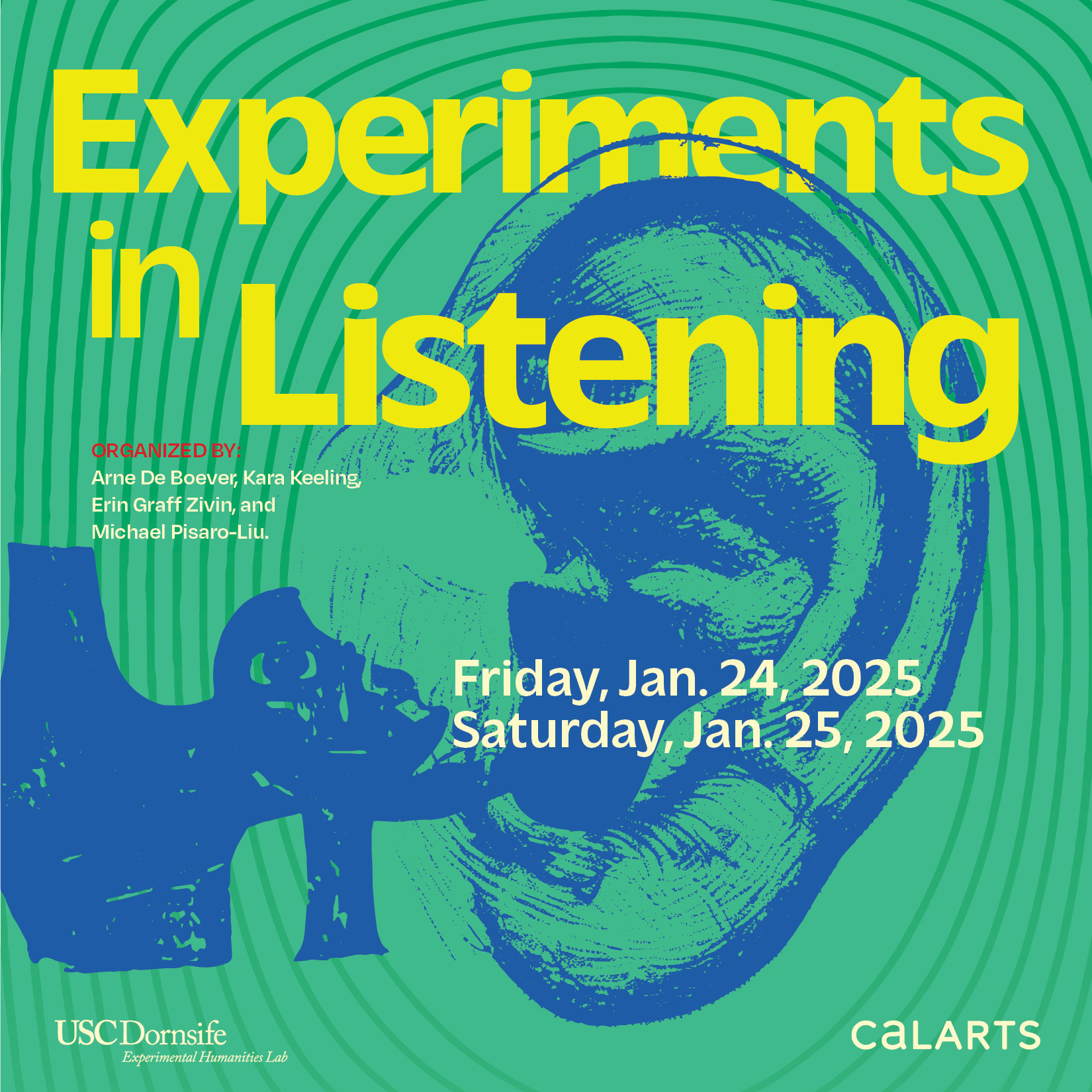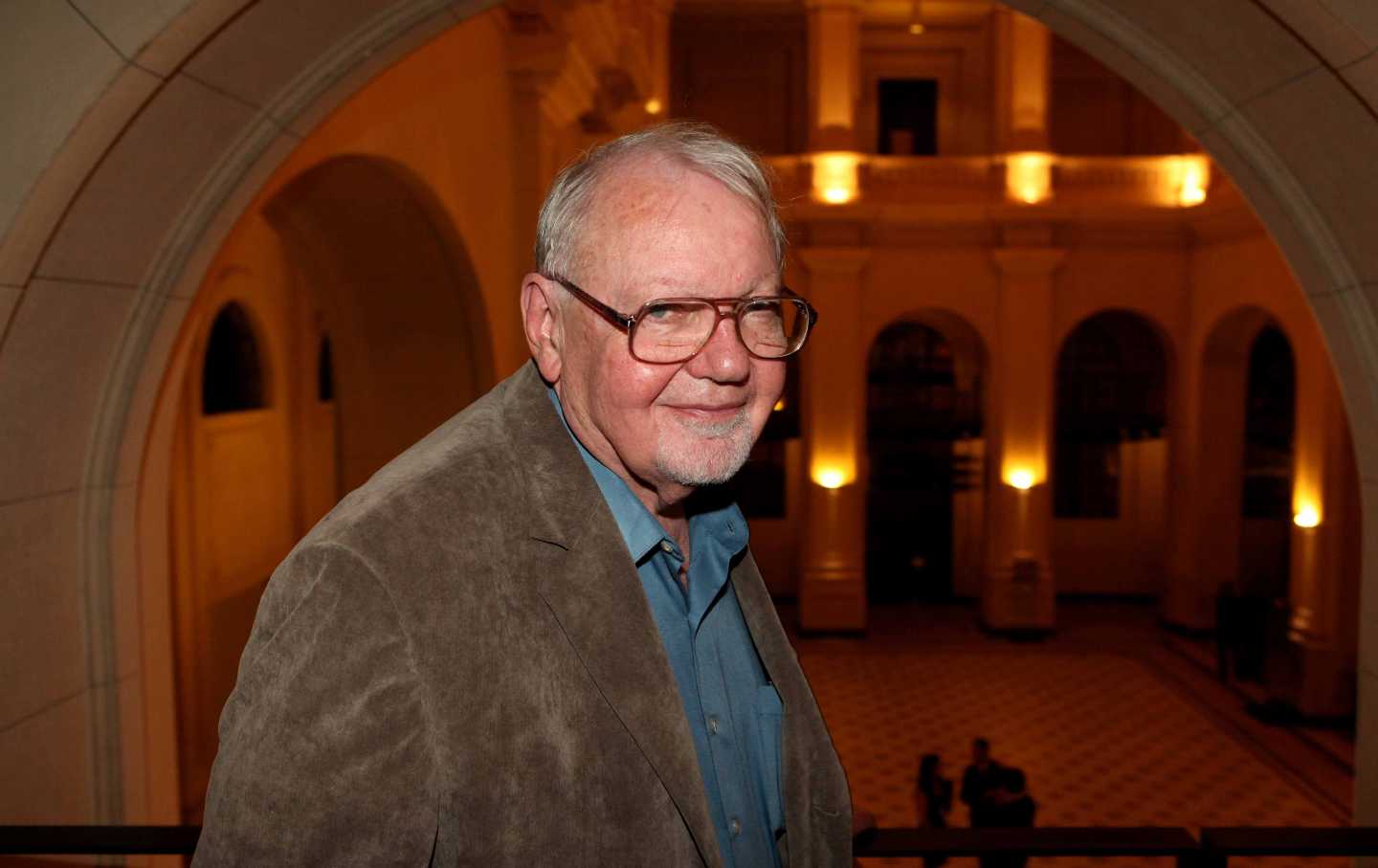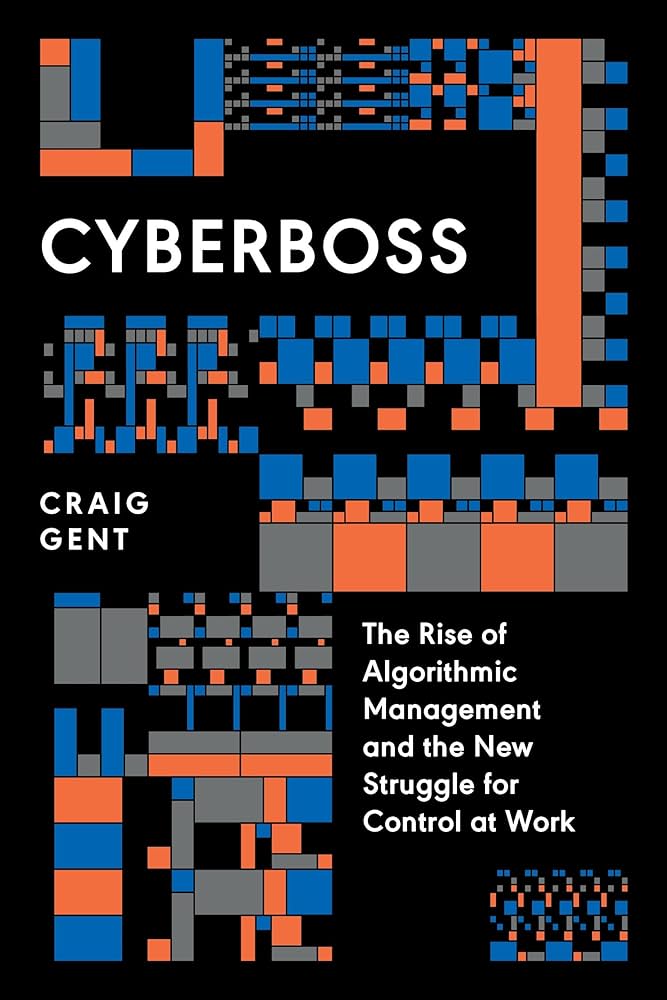The Last Manager (Review of Craig Gent’s Cyberboss: The Rise of Algorithmic Management and the New Struggle for Control at Work)
Marc Kohlbry
The common man wasn’t nearly as grateful as he should be
for what the engineers and managers had given him.
—Vonnegut (1952, 220)
In early 2024, Bill Anderson, CEO of the pharmaceutical giant Bayer, took to the pages of Fortune to announce the end of management. Citing the difficulties posed to sustainable growth by cumbersome workplace bureaucracy and hierarchies, the op-ed details his company’s plan to fundamentally restructure 100,000 positions across its various business units. Under the banner of “Dynamic Shared Ownership,” Bayer will do away with 99% of its 1,362-page corporate handbook in hopes of becoming “as agile and bold as a startup” (Anderson). In its absence, employees will “self-manage,” forming “self-directed teams” endowed with the freedom to select new projects every 90 days and to sign off on one another’s ideas along the way—all “without a manager in sight” (Royle). This “radical reinvention,” he promises, will “liberate our people” and save the company upwards of $2.15 billion, notably by first liberating thousands of middle managers from their employment contracts.[1]
While Anderson’s op-ed stops short of clarifying exactly how these self-directed teams will cooperate to achieve Bayer’s corporate goals (an equation typically solved by managerial personnel), a more recent New York Times article, “If A.I. Can Do Your Job, Maybe It Can Also Replace Your C.E.O.,” indicates what the means to such ends might be. There, journalist David Streitfeld suggests that emerging technologies, namely those driven by generative AI, stand poised to take over executive decision making by analyzing new markets, discerning trends, and communicating with colleagues. “Dark factories, which are entirely automated,” he ventures, “may soon have a counterpart at the top of the corporation: dark suites” (Streitfeld 2024).
The rationale behind these structural shifts is simple enough: because middle- and upper-management positions are highly compensated, eliminating them can result in considerable savings for employers. Faced with a growing market bubble[2], companies like OpenAI might see in this an opportunity to deliver shareholder value by developing products capable of carrying out supervisory tasks and of supporting (that baleful corporate euphemism) workers’ efforts to manage themselves. As one former IBM consultant notes, the change delivered by AI in corporations could accordingly be “as great or greater at the higher strategic levels of management as [in] the lower ranks” (Streitfeld 2024). Indeed, for some, replacing managers with algorithms or LLMs appears as common sense: “[s]omeone who is already quite advanced in their career and is already fairly self-motivated may not need a human boss anymore,” intimates Phoebe V. Moore, a professor of management and author of The Quantified Self in Precarity: Work, Technology and What Counts (Routledge, 2017). “In that case, software for self-management can even enhance worker agency” (Streitfeld 2024).
*
But what might such changes actually mean for work and those who carry it out? Put otherwise, in taking up the managerial function, are information technologies truly capable of enhancing worker agency? Craig Gent’s Cyberboss: The Rise of Algorithmic Management and the New Struggle for Control at Work—an adaptation of his 2018 doctoral dissertation—responds by offering readers a powerful and timely excavation of how new workplace technologies are in fact making workers of all stripes less free—“not by chance but by design” (Gent 2024, 3). This “design,” Gent conveys across the text’s six chapters, is propped up by “algorithmic management,” “a way of organizing work in which workers are directed, monitored, tracked and assessed—all at once, in real time—by a computer system that doesn’t rely on a human manager to control it” (3-4). In an observation that recalls the motivations behind Bayer’s $2.15 billion experiment in self-management, Gent notes that, “for most practical work, human workers are simply cheaper, more reliable and easier to replace than robots” (4). Managers, it turns out, are not.
Building on this logic, Cyberboss takes stock of the true consequences of work under algorithmic management, where “poor employment protections, high workloads and advanced technology conspire to create high-turnover jobs that come with a harsh toll of mental and physical exhaustion” (3). By concentrating his attention on these dynamics in the (UK) logistics sector (while acknowledging that they define the gig-economy as a whole), Gent identifies that the core goal of Cyberboss is to—as its epigraph from Mark Fisher would have it—“destroy the appearance of a natural order” held together by algorithmic power.
In Chapter 1, “The Stakes,” Gent outlines three analytical strokes for fulfilling this goal. In the first, his study seeks to demystify the aforementioned natural order by tracking how contract workers are compelled to work in accordance with “objective” standards set by seemingly infallible calculations and analytics (3). Second, Cyberboss looks to illuminate a crippling blind spot of the contemporary labor movement, whose myopic focus on contract recognition and related concession that a company’s “right to manage” is “its business alone” both foster the unchecked exploitation of “flex” workers that is itself operated by management and workplace technologies (13). Finally, Gent endeavors to counter extant scholarship on algorithmic management in particular and gig-work more generally by identifying the limitations of calls for such technologies to be made more “transparent,” “explainable,” and “human-centered”; emanating from academics and trade unions alike, these demands, he will later insist, fall short by proposing a “technical solution to a political problem” (23).[3]
According to Gent, what is needed instead is a “political understanding of algorithmic management on its own terms” (8). Yet, “it is important not to disappear into the abstract,” he cautions (23). Instead, “[b]ecause the politics of algorithmic management is so intimately entwined with the organisation of work, it is necessary to show how such workplaces function in practice” (23). To do so, Cyberboss concerns itself “more with discipline and management” than with wages or the effects of material precarity outside of the workplace (11). In sum, Gent explains, “I want to question what the stakes are for workers and work, and what it means for technologies of control and communication to be sites of struggle and contestation” (12). This line of inquiry ultimately permits Cyberboss to generatively account for how “workers are being managed by computers rather than replaced by them” “on the basis of cybernetic feedback loops” (6), then to reveal how workers are fighting back outside of the traditional organizational structures of the labor movement.
To fully grasp how Gent arrives at these conclusions, it is instructive to read ahead to Cyberboss’s fourth chapter, “Technological Politics.” In this somewhat belated methodological introduction, Gent surveys several dominant views of technology’s relationship to sociopolitical dynamics. Judging “technological determinism,” “social determination” (109), and the “economic view of capitalist innovation” (113) as insufficient, he instead privileges a “theory of technological politics” aimed at accounting for the “political dynamics—in other words, class relations—that are immanent to technology” (114). In lieu of “saying technology is determined by political dynamics,” this perspective focuses on how “the scale, design or organisation of certain technical arrangements can engender technological imperatives that command particular social responses” (115).
Rather than target capital’s conceptual abstractions, structural dynamics, or technical artifacts, Gent leans on the theory of technological politics to construct a markedly ethnographic methodology (119). “Uncovering the conflictual political interests that have been concealed, circumvented or naturalized,” he argues, “requires empirical investigation with the aim of showing that labour is never completely subordinated to capital” (132). The point, he continues, is not simply to understand relations of power, but to empower workers by unconcealing the “ongoing contingency of class struggle from within work, quite aside from any sweeping structural principles or managerial ideals we might identify” (133). Taking as a point of departure the so-called Trontian inversion—or, the insistence on “the primacy of working-class struggle within the development of capitalism”—Gent grounds Cyberboss in autonomist Marxism’s insights about how “the working class has political agency regardless of the conditions imposed upon it by either capital, the state, or traditional political vehicles such as trade unions or workers’ parties,” all while emphasizing workers’ ability to contest the dominative power of capital (117, 120). Indeed, he maintains, “the indeterminacy of technology […] leaves open the possibility that workers will contest managerial techniques as implemented through specific technologies” (123). With his sights set on the “indeterminacy” of algorithmic management, Gent finds in autonomism not only a political framework that registers how “technology is always subject to ongoing class struggle,” but a set of concepts and tools with which to effectively “develop an account of technology at work” (120).
Among these, Gent singles out the workers’ inquiry (as developed by Romano Alquati in 1975’s Sulla FIAT) for its ability to trace “class composition,” a move that turns back the clock on post-operaismo by framing ethnography as a means of explicating particular sites of class struggle rather than zooming further out in an attempt to assess the composition of the working class as a whole (137). By centering pickers in UK distribution centers as well as couriers working for similar facilities or on lean platforms, Gent skillfully explicates how “capital and the working class are specific but relational” (130) by analyzing algorithmic management technologies as both “a prism through which to understand contemporary class struggle and an under-studied component of regimes of ‘control’ in contemporary workplaces” (137). Workers’ inquiries form the core of these analyses; however, they also serve as dynamic supplements to Gent’s assessments of the intellectual histories, media objects, and conceptual abstractions that gave rise to and continue to fuel algorithmic management. Woven together, these threads forcefully clarify the concrete fallout of this managerial mode as well as the forms of worker resistance that have risen to counter it.
A pivotal moment in this approach comes in the third chapter of Cyberboss, “Management,” which details how algorithmic management “combines three key traditions in management thought: the scientific, the humanistic and the cybernetic” (65). Beginning with the observation that management is, “in its essence, a political project” representing “a formal and intentional division of power, information, communication and control in the workplace” (64), Gent momentarily brackets out the question of digital technology to trace the means and ends of the managerial function both historically and in the present. He begins by surveying the tradition of scientific management promoted by Frederick Winslow Taylor at the turn of the twentieth century. Understanding labor power to be a commodity that, when purchased, merely offers the potential for labor, Taylor identified the goal of management as the actualization of that labor power (68). The defining feature of this approach—or Taylorism—would ultimately be its deskilling of manual labor and subsequent separation of the conception and execution of work. This design made managers responsible for “applying detailed measurement to each element of work” (67). Under Taylorism, then, the managerial conception of labor consists of “the knowledge and planning of the labour process, the development of strategy” (76), while its execution is the eventual cooperative labor of workers themselves. Critically, the “knowledge put into the process by managers is initially gleaned” from the workers, which enables supervisors to “generate [the] general rules and targets that will govern the work process” (76-77).
Gent continues his survey of capitalist management by registering an important corrective made to Taylor’s thinking by Frank Bunker Gilbreth, Lillian Moller Gilbreth, and Elton Mayo. In Gent’s retelling, this shift represents the “humanistic tradition,” which belies the realization that scientific management need indulge “the human factors of the labour process” (73). Together, these thinkers urged managers to concentrate on developing affable, personal relationships with workers in order to create “social units” in the workplace; Mayo, in particular, would identify sociality as workers’ primary motivation (73). This tradition would reach its apogee in the years following World War II, largely thanks to management innovations in Japan led by Yoichi Ueno and later by Taiichi Ohno, the father of Toyotism, lean manufacturing, and “total quality control.” These markedly humanistic upgrades to Taylorism, Gent explains, would break with the idea of a perfectible system by instead insisting on the continuous refinement of the labor process over time, or kaizen in Japanese (81).
To these interrelated approaches, Gent adds an important third: the “cybernetic tradition,” whose principal feature is “the use of feedback loops to control or steer a complex system (in this case, a workplace)” (6). This name—from which Cyberboss draws its titular prefix—points to both total quality control’s roughly cybernetic nature as well as to the management theories that grew from the seeds sown by Norbert Wiener’s foundational 1948 text, Cybernetics: Or Control and Communication in the Animal and the Machine. “As an adaptive, continuous system,” Gent clarifies, “total quality control retains ideas from scientific management about the reformulation of knowledge to produce targets, but adopts a more holistic, and arguably cybernetic, form: beyond work rates, [it] is concerned with managing work relations through communication and delivering wide control to management through attention to intra- and inter-departmental dynamics” (82). “Cybernetic” management thus creates a company-wide circuitry of feedback-based control (called a “quality-control circle”) through which “management can control various aspects of the work process by communicating with workers and encouraging their cooperation” on the basis of the information gathered from those workers as they carry out their tasks (83-84).
Further on, Gent turns to certain core thinkers of “cybernetic management” (namely Stafford Beer) to detail how, in viewing the firm as a cybernetic feedback system, this third tradition shirks purely hierarchical control and total knowledge of the work process to instead “exercise control […] by virtue of [managers’] position within communicative flows” (96). To illustrate how this approach underpins “algorithmic” management, Gent observes that the scanning guns used by Amazon pickers mediate a process of informatic feedback. While “the separation of conception and execution persists” and management was “still present [there] in a number of ways,” these Motorola WT4000 scanners would dictate to workers the next item to be picked all while displaying a real-time evaluation of their performance (88-91). Behind the scenes, the interface was tracking and collecting performance data and in turn using that information to adjust the labor process in keeping with established productivity targets. Yet even though (or because) “[n]o one could say how the […] targets were set” (101), each data-driven adjustment appeared as neutral, objective, rational, and, above all, “beyond question” (99-100). Further, while these workers at times would intermittently interact with a human manager, they were more often in communication with “the system,” another name for “a computer database (or databases) that manages stock or order progress, tracks the work of employees, time-stamps activity, calculates performance and assigns new tasks where necessary” (101).
These ethnographic observations lead Gent to a series of sweeping theoretical conclusions about algorithmic management. In addition to drawing on “the separation of conception and execution advocated by Taylor and the continuous improvement impulse of kaizen,” digital tools such as the scanner mediate “performance-orientated feedback loops” all while introducing “new dimensions to the workplace that force us to rethink what communication and mediation mean at work” (105-106). In the logistics sector, these “new dimensions” weigh on managers and workers alike. For the former, technologies like the scanner maximize worker efficiency by leaving the calculative aspects of conception to algorithms, which frees them up to smooth out any kinks in the labor process through direct communication with workers. For these workers, the execution of labor comes to resemble what Jamie Woodcock calls the “algorithmic panopticon,” or a form of workplace governance without a physical managerial presence wherein interaction with digital interfaces and platforms contributes to a “feeling of being constantly tracked or watched” (107).
Nevertheless, Gent insists that the control posited by this “algorithmic panopticon” is illusory, a position that he defends across the chapters “Algorithmic Work” and “Algorithmic Management.” In a way, these chapters take up the division of labor proposed by Taylorism, but in reverse: the first focuses more on descriptions and analyses of the execution of labor in the logistics sector, whereas the second concentrates on the means and ends of its conception (though, given Cyberboss’s privileging of workers’ perspectives, there is considerable overlap between the two). These examinations support Gent’s reasoning that “the principal idea governing contemporary logistics is to minimise ‘waste’” by (in part) ensuring that workers are as “productive as humanly possible” (16-17). This is where algorithmic management steps in: by assigning, administrating, measuring, and assessing this work in real time, its technologies
cover the allocation of work, the direction of the employee towards particular items, the employee’s performance against a pick rate (itself set by the algorithm according to online order traffic), and the direction of supervisors towards workers who fail to meet targets. In such cases, algorithmic tracking and decision-making are either augmenting or replacing the traditional managerial or supervisory function. (26-27)
Such an approach reduces logistics workers to a series of data points, or information, which is then measured on the basis of productivity targets and surveillance before being “fed back” into the system to maximize efficiency (and discipline workers who underperform) (28).
To demonstrate how this takes place in the logistics sector, Gent elaborates specific forms of media that render workers as “tools of the algorithmic system” (40). Hardly dead media, the scanner, the barcode (41-42), digitally-augmented goggles (42), and even VR headsets (44) enable management to control individual workers by “transforming each […] into an embodied real-time data tracker” (42). The information gathered by such devices facilitates this determination in two movements. First, it allows “the system” to determine which workers will work and when; “[l]ike the goods in the warehouse, [these] workers are forever just-in-time” (152). Second, once workers are on-site, this same data is used to subject them to circular work patterns (a more concrete feedback loop), the instructions for which are set computationally and displayed on the digital devices themselves (147). “Much of the skill involved in successfully carrying out the work,” Gent goes on to highlight, “boils down to successfully acting on the basis of a digital interface” (149). This has the upshot of focusing workers’ attention on hardware and thus of minimizing communication between them (157). To prevent a total breakdown in sociality, then, the role of actual managers shifts toward “humanistic intervention” capable of ensuring that work (and its improvement) remains a “continuous process” rather than a “goal-oriented sequence” (169, 160). In sum, while “algorithmic management operates within a Taylorist paradigm, it signals a key development in terms of its ability to decentralise the managerial endevour by distributing power across the workforce in a more democratic way, but by way of a digital media infrastructure within which real-time cybernetic feedback loops produce a more generative form of control” (171).
This new reality, Gent warns in “Guile Against Adversity,” “poses significant issues for how we think about the capacity of workers to exercise agency within the work process” (173): increasingly faced with a system able to “fill gaps in labour” and “redirect work processes to other locations in real time,” “we can no longer rely on forms of political mobilisation that have become our common sense” (176-177). Rather than lay plans for a future political strategy (predicated on unions, strikes, and so forth), this final chapter focuses on contingent employees’ resistance to algorithmic management in “actually existing workplaces” (203). Reframing instances of “everyday resistance” and “organisational misbehavior” (178) as “metic resistance” (201), or “workers’ guile,” Gent highlights “the use of situated wisdom and experiential cunning to seize or subvert, even momentarily, the current of managerial control” (203). But while such acts[4] are capable of “reappropriating personal dignity,” Cyberboss’s author also acknowledges that it remains an open question whether metic resistance—as well as the new forms of worker sociality and “chains of discovery” that make them possible (which he terms “metic commonality”)—can be “scaled up or generealised across a workforce as part of a collective endeavour” (198, 205). Still, “[b]y thinking about resistance in terms of metis,” Gent maintains, “we are forced to consider the situatedness of political action away from ideal types, such as those found in the organiser’s repertoire” (205).
Beyond its contributions to our understanding of the gig economy and provocative assessments of the emancipatory possibilities available to workers under algorithmic management, Cyberboss also makes crucial interventions in pressing social-scientific conversations at the nexus of political economy and digital culture. Importantly, the text grounds scholarly interest in the logistics sector (as both a site of exploitation and a possible choke point for resistance) in what one might call a social history of algorithmic management—that is, a theorization of technology’s relationship to the capitalist division of labor rooted in actually existing workplaces rather than in idealism, however cogent its political leanings. This perspective informs Gent’s skepticism of “[a] growing number on the left [who] wish to see social movements emerge around the logistics sector” (60), which later leads him to conclude that locating the strategy of “fault lines and weak points” in logistics “falters against the scale of [algorithmic] managerial control” (202). One could certainly be persuaded by this point in taking seriously Cyberboss’s arguments; however, Gent’s account is also a complementary rejoinder to work on this subject by Aaron Benanav, Jasper Bernes, or Søren Mau, who have made incisive points about how, under capitalism, “mobility is power, and means of transportation and communication are weapons.” (Mau 2023, 273). To these more structural positions, Gent lends the voices of workers to reorient conversation toward, in the context of logistical power, what it is that’s to be done—though stops short of leveraging this essential move into an affirmative elaboration of the kinds of broader, coalition-based strategy that will be necessary to effectively fight back.
Elsewhere, Cyberboss generatively nuances certain of Mau’s arguments about “economic power,” or that which is “not immediately visible or audible as such, but just as brutal, unremitting, and ruthless as violence; an impersonal, abstract, and anonymous form of power immediately embedded in the economic processes themselves rather than tacked onto them in an external manner” (Mau 2023, 4). Importantly for the present purposes, Mau postulates that management, or“[t]he authority of the capitalist within the workplace,” is the mere “form of appearance of the impersonal power of capital”; formulated otherwise, “[t]he despotism of the workplace is nothing but the metamorphosis of the impersonal and abstract compulsion resulting from the intersection of the double separation constitutive of capitalist relations of production” (233, italics in original). By this token, Cyberboss brings Mau’s cursory insights about how the managerial function directs economic power to bear on the question of algorithmic power, in turn pointing the way to a fuller understanding of how technology might mediate “mute compulsion” in the digitized workplace along “multifarious points of communication” (Gent 2024, 170). If “management at work is the primary means by which most people experience the phenomenon of capitalism in daily life” (65), Gent’s arguments suggest that, by replacing managers with technologies aimed primarily at the production of surplus value, algorithmic management presents workers with an experience of the value form that is paradoxically more abstract and concrete than that animated by previous managerial modes—more abstract because it is immaterial and non-human, more concrete because it offers a less mediated experience of the abstracting movements of capital. Here, more concentrated study of the place of technology in capital’s abstract domination of the concrete—particularly in the context of managerial practice—appears as particularly urgent.
Gent’s study also vitally reasserts the centrality of management for cybernetics (and vice-versa), a point of convergence that is among the most enduring afterlives of the science; indeed, before migrating into anthropology, linguistics, or “French theory,” this model for communications engineering was motivating managerial thought and practice.[5] Read in this context, Cyberboss’s focus on “actually existing workplaces” provides a materialist explanation for the cybernetic underpinnings of contemporary capitalism, a welcome supplement to more recent studies of the ideological impact of the science of communication and control on neoliberal economics.[6] On this basis, Gent’s discussion of cybernetics underscores the need for research into how the science’s successive historical stages—i.e., first-order, second-order, or, later and by extension, systems theory—respectively modified the coordinates of the “scientific” and “humanistic” managerial traditions to which Cyberboss so urgently draws our attention.
Further afield, Cyberboss should provoke similar (if perhaps uncomfortable) questions for scholars in the humanities. There, it is no secret that “cybernetic” thought has served as inspiration for a range of fields from posthumanism to poststructuralism thanks to the “ontology of unknowability” (Pickering 2010, 23) typically associated with cybernetics’ more reflexive second wave. With this in mind—and following Gent’s lead in registering that this same ontology has enabled capital to actualize labor power since the mid-twentieth century—one wonders about the extent to which some strains of humanities research have been unknowingly trafficking in managerial discourse for what would now amount to decades. Such a line of inquiry is only complicated by the fact that management scientists themselves have long-since realized the use value (and not simply the exchange value) contained in the thought of Michel Foucault (McKinlay and Starkey 1998), Gilles Deleuze (Linstead and Thanem 2007), or Judith Butler (Tyler 2019), as well as in certain fields often assumed to be the exclusive province of humanistic inquiry (de Vaujany et al. 2024).
*
Without undercutting its arguments or diluting its many contributions, Cyberboss ends abruptly. A three-page epilogue briefly addresses the topic of artificial intelligence by glossing the 2023 Writers Guild of America (WGA) strike and the demands made therein for the curtailment of AI use across the film industry. “The WGA,” Gent suggests in closing, seems to have understood what “other unions ought to”: “the infeasibility of leaving technology within the realm of corporate decision making” (Gent 2024, 211). Rather than content ourselves with this nod to generative AI, however, we should push Gent’s study further to illuminate the futures of work and component forms of exploitation that these technologies may make possible—some of which are already upon us.
In early 2024, I received an unexpected job offer. The position—for which I had not applied—was that of an AI model evaluator with a company that I’ll call “Mute.” This was an opportunity, I read with some confusion, to “shape the next generation of AI with [my] expertise” while “enjoying the flexibility to work where and when” I wanted. Puzzled yet intrigued by how I might do so with a background in comparative literature, I accepted.
It was not long before I discovered that the management of this work (which Mute refers to as “tasking”) was entirely algorithmic. Once I had created an account on the company’s platform and completed the necessary “enablement” modules, the system assigned me to a project, the two pay rates for which (one for “project” tasks and another for “assessment” tasks, themselves indistinguishable in all but name) were both conspicuously lower than the promises of Mute’s initial proposition. Undeterred, I clicked the “Start Tasking” button and a new interface appeared: at the top of this window sits a timer (typically longer than the maximum amount of time a user can be paid for—a detail buried elsewhere in a project description footnote) alongside a reveal of the task type at hand.
For this first “Rewrite” project, Mute’s system instructed me to evaluate and improve single- and multi-turn LLM (large language model) responses according to the assessment categories of “instruction following,” “concision,” “truthfulness,” “harmfulness,” and the vaguer “satisfaction” (a catch-all for any issues that fail to fit neatly into another category). To move from one stage of a task to the next, I was required to “Verify” my recommendations by fixing any issues flagged by a series of inscrutable, AI-powered plug-ins.[7] Once my suggestions had been approved by these digital managers, I could “Submit” the task for evaluation by an anonymous “Reviewer”—a role, I learned following a later algorithmic reassignment, whose own tasks are evaluated by still other taskers using an identical 1-5 Likert scale. Regardless of one’s project or role, these scores contribute to an “Average Task Score,” which the system then uses to compute pay rates and assign future tasks, projects, and, if one is lucky, “bonus missions.”
The managerial function animating this division of labor operates horizontally: thanks to the system’s opaque algorithms for allocating and evaluating tasks, each tasker is unknowingly managing the work of another. But this same process is also circular: because their communication occurs textually and is mediated by standardized assessment categories, Likert scores, and other veiled parameters, taskers are transformed into algorithmic managers; cloaked in code, they become indistinguishable from the LLMs they are training (who are training them in turn). This is evident as soon as one completes a first unpaid “enablement” program, at which point they are asked to assign it a rating between 1 and 5. Within this circuit, the question of whether tasks are being evaluated by a human or an AI (or, if they are being used to evaluate the work of one or the other) is thus irrelevant.
While tasking on Mute is a solitary endeavor, it is still possible to communicate with fellow workers by clicking on a tab labelled “Community.” Doing so will launch an embedded Discourse forum featuring locked threads with updates and reminders about the project(s) to which one is assigned as well as open threads seemingly meant for more casual exchange. Among these is the “Watercooler Thread,” a name that cruelly parodies the social relations that have been dissolved by the machinations of algorithmic management. Indeed, every move on this platform is destined for capture and optimization; in Mute’s “Community,” for instance, taskers’ scrolling and keystrokes are tracked and calculated into a “Trust” level that will determine the threads and features (including personal messaging or the ability to post links) to which they have access.
This brief window into Mute’s algorithmic management highlights the explanatory power of Cyberboss—even while revealing certain of its limitations. Though not pickers or couriers, for example, Mute’s workers are similarly directed, monitored, tracked, and assessed by non-human agents in real time. And, much as Gent describes of Amazon or Deliveroo, this company’s “system” facilitates the resulting flows of data through feedback loops intended to actualize labor power. In the absence of any discernible human supervisor, however, here AI stands in as the tasker’s last manager, creating an algorithmic panopticon wherein each is the source and subject of an automated mode of control. Alarming, too, is that the sociality shaped by Mute’s platform limits workers’ ability to fight back more comprehensively than a logistics facility might with its scanners and barcodes; for instance, even if taskers dream of staging a slowdown or mass log-off to improve their working conditions, every channel (and water cooler) for metic commonality is already subsumed by the system’s gaze. In difference to the logistical distribution of material goods that Gent analyzes, then, the algorithmic power governing Mute’s immaterial labor is hardly an illusion; rather, it is totalizing, a “quality-control circle” wherein each worker is compelled to (self-)manage.
On a more speculative level, the possible ends of this self-management complicate Gent’s conclusions about the impossibility of automating the managerial function altogether. In sum, Mute’s evaluators are carrying out the microwork that maintains LLMs’ veneer of “intelligence,”[8] including editing responses for grammar and syntax, identifying and correcting hallucinations, and generating datasets through which such tools might be trained to better respond to contextual and affective cues. The technical name given to this more general form of labor—which, as one of my Mute training modules clarified, draws on taskers’ “human knowledge and expertise” to craft products “far superior to an AI like ChatGPT”—is unmistakably cybernetic: “reinforcement learning from human feedback,” or RLHF.
But what of the products that these efforts might generate, and to whom could they be sold? After first being contacted by Mute, I quickly gleaned that the company is the labor-supplying subsidiary of a much larger B2B firm who counts OpenAI, Meta, Microsoft, and Nvidia among its clients. To prevent the most recent tech boom from becoming a bust, organizations like these have begun searching for ways to deliver AI solutions to businesses that will ensure model accuracy, secure company and customer data, minimize response bias, and, above all, feel irrefutably human. One path to this is the increasingly popular “retrieval-augmented generation” (RAG) approach, which allows the LLMs that it powers to retrieve information that is external to the datasets upon which they’ve been trained. In theory, AI infrastructures grounded in RAG can provide accurate and secure LLMs tailored to companies’ “enterprise resource planning” (ERP), “customer relationships management” (CRM), and “human capital management” (HCM) systems and needs. Conceivably, then, Bayer could hire Mute’s parent company (or one of its marquee clients) to build a RAG-powered LLM based on customized HCM datasets and the protocols laid out in their 1,362-page corporate handbook. By actualizing the necessary labor power correctly and at scale (e.g., by way of RLHF)[9], Mute’s algorithmic management could present IG Farben’s heir with its own algorithmic means of hiring, onboarding, and directing workers—or, of taking up the role of “humanistic intervention” to communicatively support self-management, much as AI is already doing for those of us on Mute’s lean platform.
Nevertheless, it would be a mistake to hastily conclude that the algorithms fueling generative AI models and other digital technologies will soon (or ever) be capable of fully automating the role of management. This natural order Gent only partially decodes: because such objects will always require a self-organizing subject[10], we must summon whatever guile we can—together with the lessons of Cyberboss and the future work it should inspire—to collectively resist becoming our own last manager.
Marc Kohlbry received his PhD in comparative literature from Cornell University in 2022. His research centers on the intersections of literature and media, digital culture, and political economy and has been published or is forthcoming in such journals as Social Text, New Literary History, and Cultural Critique.
Thanks to Sam Carter for his incisive reading of a previous draft of this essay.
[1] Shoring up stock valuations by cutting managerial positions is hardly novel, let alone “radical.” In 2023, for instance, middle managers—i.e., nonexecutives who oversee other employees—accounted for almost a third of global layoffs, with notable cost-saving measures being implemented at Meta, Google, Citi, and FedEx (Olivia 2024).
[2] See Cahn 2024.
[3] Relevant examples can be found in Rosenblat 2018, Aloisi and de Stefano 2022, and Ajunwa 2024.
[4] These include “the exploitation of menu options to bring about breaks; the stealing and sharing of supervisors’ codes or computer log-in details; use of the knowledge of what supervisors can and can’t know, and how busy they will be at a given moment, to amuse oneself and create problems for the stock database; defiance of the narrow forms of communication demanded by interfaces; the shared experience invoked in slowing down to 70% of productivity, reasserting workers’ autonomy over performance; [and] the ingenuity of testing new equipment in order to find new ways to subvert it” (Gent 2024, 207).
[5] For evidence of this, one might look to Norbert Wiener’s comments on industrial management (briefly discussed by Gent 2024, 12) as well as to Beer 1959.
[6] For examples, see Hancock 2024, Oliva 2016, or Haplern 2022.
[7] Frequently, these algorithmic management tools claimed that “AI [had been] detected” in an entry, an issue that I could “Agree and Fix” or “Decline”—there is no third option for informing the LLM that it was, in fact, mistaken.
[8] See also Altenried 2020, Crawford 2021, 53-87.
[9] At the time of this writing, these efforts—and any resulting profits—still seem out of reach. See Sam Blum’s recent reporting on the subject for Inc.
[10] Still, the automation of management strikes me as somewhat more feasible than the “proletarianization” of artificial general intelligence (AGI) (Dyer-Whitheford et al. 2019, 135-138). For my thinking on the means by which digital interfaces might facilitate the former process, see Kohlbry 2024.
References
Ajunwa, Ifeoma. The Quantified Worker: Law and Technology in the Modern Workplace. Cambridge, UK: Cambridge University Press, 2023.
Aloisi, Antonio and Valerio de Stefano. Your Boss Is an Algorithm: Artificial Intelligence, Platform Work and Labour. London: Bloomsbury Publishing, 2022.
Altenried, Moritz. “The platform as factory: Crowdwork and the hidden labour behind artificial intelligence.” Capital & Class, 44:2, 2020: 145-158.
Anderson, Bill. “Bayer CEO: Corporate Bureaucracy Belongs in the 19th Century. Here’s How We’re Fighting It.” Fortune, 21 Mar. 2024, https://fortune.com/2024/03/21/bayer-ceo-bill-anderson-corporate-bureaucracy-19th-century-leadership/.
Beer, Stafford. Cybernetics and Management. English Universities Press, 1959.
Blum, Sam. “‘It’s a Scam.’ Accusations of Mass Non-Payment Grow Against Scale AI’s Subsidiary, Outlier AI.” Inc., 14 June 2024, http://inc.com/sam-blum/its-a-scam-accusations-of-mass-non-payment-grow-against-scale-ais-subsidiary-outlier-ai.html.
—. “Scale AI Lays Off Workers Via Email With No Warning.” Inc., 27 Aug. 2024, https://www.inc.com/sam-blum/scale-ai-lays-off-workers-via-email-with-no-warning.html.
—. “A Scale AI Subsidiary Targeted Small Businesses for Data to Train an AI. Entrepreneurs Threatened Legal Action to Get Paid.” Inc., 28 Aug., 2024, https://www.inc.com/sam-blum/a-scale-ai-subsidiary-targeted-small-businesses-for-data-to-train-an-ai-entrepreneurs-threatened-legal-action-to-get-paid.html.
Cahn, David. “AI’s $600B Question.” Sequoia Capital, 20 June 2024, https://www.sequoiacap.com/article/ais-600b-question/.
Crawford, Kate. Atlas of AI Power, Politics, and the Planetary Costs of Artificial Intelligence. New Haven: Yale, 2021.
de Vaujany, François-Xavier et al. Organization Studies and Posthumanism: Towards a More-than-Human World. London: Routledge, 2024.
Dyer-Whitheford, Nick, et al. Inhuman Power: Artificial Intelligence and the Future of Capitalism. London: Pluto Press, 2019.
Gent, Craig. Cyberboss: The Rise of Algorithmic Management and the New Struggle for Control at Work. New York: Verso Books, 2024.
Halpern, Orit. “The Future Will Not Be Calculated: Neural Nets, Neoliberalism, and Reactionary Politics.” Critical Inquiry, 48:2, 2022: 334-359
Hancock, Max. “Spontaneity and Control: Friedrich Hayek, Stafford Beer, and the Principles of Self-Organization.” Modern Intellectual History, 2024: 1–20.
Kohlbry, Marc. “Technologies of Hope (Fiction, Platforms, Management).” Social Text, 42:4, 2024: 51-79.
Linstead, Stephen and Torkild Thanem. “Multiplicity, Virtuality and Organization: The Contribution of Gilles Deleuze.” Organization Studies, 28:10, 2007: 1483-1501.
Mau, Søren. Mute Compulsion: A Marxist Theory of the Economic Power of Capital. New York: Verso Books, 2023.
McKinlay, Alan and Ken Starkey. Foucault, Management and Organization Theory: From Panopticon to Technologies of Self. SAGE, 1998.
Oliva, Gabriel. “The Road to Servomechanisms: The Influence of Cybernetics on Hayek from the Sensory Order to the Social Order.”The Center for the History of Political Economy Working Paper Series, 2015, https://ssrn.com/abstract=2670064.
Rosenblat, Alex. Uberland: How Algorithms Are Rewriting the Rules of Work. Oakland: University of California Press, 2018.
Royle, Orianna Rosa. “Pharmaceutical Giant Bayer Is Getting Rid of Bosses and Asking Nearly 100,000 Workers to ‘Self-Organize’ to Save $2.15 Billion.” Fortune, 11 Apr. 2024, https://fortune.com/europe/2024/04/11/pharmaceutical-giant-bayer-ceo-bill-anderson-rid-bosses-staff-self-organize-save-2-billion/.
Streitfeld, David. “If A.I. Can Do Your Job, Maybe It Can Also Replace Your C.E.O.” The New York Times, 28 May 2024, https://www.nytimes.com/2024/05/28/technology/ai-chief-executives.html.
Tyler, Melissa. Judith Butler and Organization Theory. London: Routledge, 2019.
Vonnegut, Kurt. Player Piano. New York: The Dial Press, 1952.











